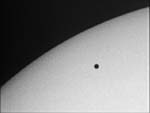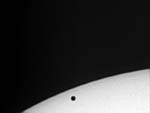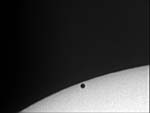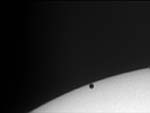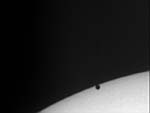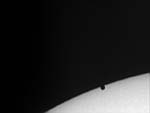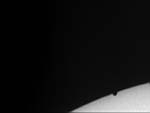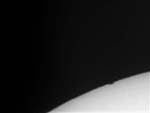
MERCURY TRANSIT
MAY 7, 2003
On May 7th, roughly between 5:11 UT and 10:32 UT, a Mercury transit happened.
Mercury crossed the sun's disc.
Astronet and
Copernicus Public Observatory in cooperation with the Dutch educational website
Kennislink ("Knowledge Link") organised a
live webcast of the event from the Netherlands.
The Mercury transit was very well observed from many countries. On this page
we will display the nicest images and movies.
Mira Public Observatory at Grimsbergen, Belgium captured the last contact.
More images by Mira Public Observatory.
Copernicus Public Observatory in the Netherlands bid farewell and as see you during the Venus transit
of June 8, 2004:
Professor Rob Rutten, of the Sterrekundig Instituut Utrecht & Institute of Theoretical
Astrophysics Oslo kindly communicated this picture taken with the Dutch Open Telescope (DOT)
at the Observatorio del Rogue de los Muchachos (ORM) on La Palma.
The image displays Mercury at high angular resolution with the solar chromosphere
in the background. The image is taken in the Ca II H resonance line of once-ionized calcium. Seen in the light of
these particles, the solar atmosphere is sampled a few hundred kilometer above the surface
seen in white light. This layer is called the chromosphere (but it is not blue, the color below
is fake; actually the chromosphere is purple (Halpha + Hbeta) seen in eclipse at contact
and in prominences, hebce the origin of the name). It shows a vivid, fast-changing scene in
which the bright patches mark strong magnetic fields and the mottled filamentary structures
elsewhere are a combination of waves and brightness-reversed solar granulation.
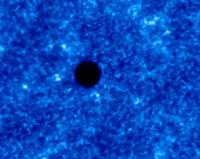
DOT |
The Swedisch 1-m Solar Telescope (SST) of the Royal Swedish Academy of Sciences on the Canary Islands captured these stunning pictures
during the last contact:
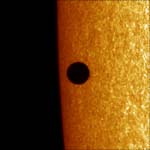 10:27:26 UT
10:27:26 UT |
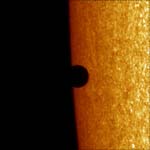 10:30:11 UT
10:30:11 UT |
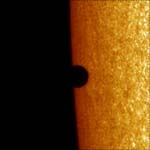 10:30:24 UT
10:30:24 UT |
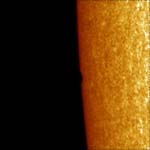 10:33:04 UT
10:33:04 UT |
SOHO
SOHO, a NASA/ESA solar research satellite in a halo orbit around the Lagrange point L1 at
1.5 million km from the Earth in the direction of the Sun, made an mpeg-movie with its
Michelson Doppler Imager (MDI). Since SOHO was slightly "ahead"
of Earth in its halo orbit, Mercury's shadow caught up with SOHO a little later than
with observers on Earth. The transit started at 7:50 UT and ended at 13:17 UT. SOHO
made a very nice mpeg-movie.
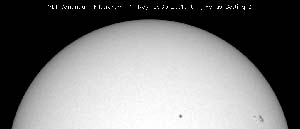
Mpeg-movie with SOHO's
Michelson Doppler Imager (MDI) |

Image taken with SOHO's
Extreme ultraviolet Imaging Telescope (EIT) |
Astronet is receiving very nice images from all over the world. One of the nicest and
sharpest images we saw so far is this composite picture by D. Dierick from
Ghent, Belgium:
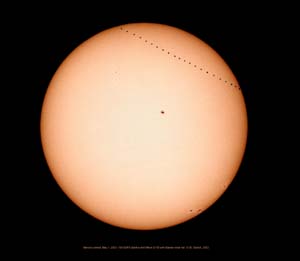
Images taken with a 155 mm EDFS Starfire
refractor and a Nikon D100 digital camera. |
Enrico Perissinotto from
Talmassons, Friuli (North Italy). made this stunning mosaic. He used an
Astro-Physics 130 EDFS at f12, prism of Hershel Baader and filter ND 4,
Web Cam Philips ToUcam Pro.
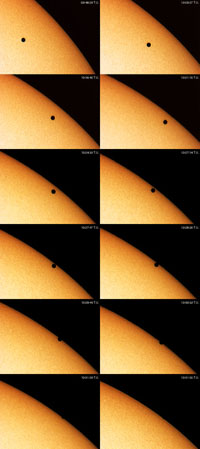
Enrico Perissinotto |
Enrico Perissinotto's results can also be admired at his
Galleria Foto page.
The Mercury transit has also been recorded by Henk Masselink and Henk Bril, with
assistance of Marion Iris van der Linden, using a Philips ToUCam PRO camera (webcam)
that was attached with a adapter, constructed by Herman ten Haaf, in the primary focus
of a 8”Celestron C8 Schmidt Cassegrain telescope fitted with a Mylar solarscreen filter.
The images werd recorded on a notebook PC (Celeron 1100 MHz processor with 128 Mb internal
memory) through the USB-port with the standard software of the ToUCam PRO (VRecord) as
AVI-file. A movie with a duration of 15 seconds makes a file of ca. 90 Mbyte with the
chosen resolution of 640x480 and 15 images/second. For the editing all movies were
transformed to bmp-files using the AVI2BMP software. The BMP’s werd stacked and edited
using ASTROSTACK2. In this process 15 images were stacked to one image. A number of images
were eventually transformed back to AVI (and MPEG) using Pinnacle Studio 8 SE. An
overall acceleration of a factor 5 was obtained because each image was frozen for
0.2 seconds.
With his webcam images Henk Bril was able to determine acurate times of contact for his observing
place (N 51º02’14”; E 5º52’08”; +35 m):
T3: UT 10h28m21s ± 2s
T4: UT 10h32m26s ± 4s
Astronet further received the following images of the Mercury transit.
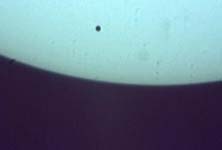
Wylliam Robinson
(Netherlands)
|
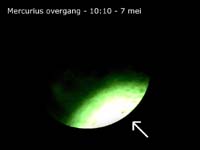
Tim Kraayvanger
(Netherlands)
| 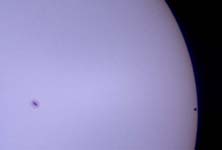
Marco Verstraaten
(Netherlands)
|
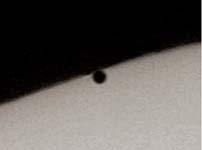
Johannes Schedler
(Austria)
| 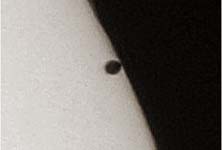
Johannes Schedler
(Austria)
|
Astronet welcomes more images to be included in this special page!
OTHER WEBCASTS
ESO: Mercury Transit on May 7, 2003 - Central display and webcam
France: L'Observatoire de Paris
Germany: Baader Planetarium
Germany: Sternwarte Peterberg
France: Association NOVAE, l'Observatoire de la Côte d'Azur, Nice
Belgium: Mira Public Observatory, Grimbergen
Belgium: D. Dierick, Ghent
Canary Isles: SAROS
Canary Islands: Swedish 1-m Solar Telescope (SST)
Hong Kong: Hong Kong Astronomical Society
Japan: Live Universe
India: Nehru Planetarium
England: Worth Hill Observatory
Spain: Planetario de Madrid
Spain: Universitat de Barcelona
Spain: Universidad Complutense de Madrid
Greece: Perseus
Denmark: Astronomisk Forening for Køge Bugt
Australia, India, Canary Islands: NSO/GONG
Austria: Sonnenobservatorium Kanzelhöhe
Austria: Verein Kuffner-Sternwarte (Wien)
Dubai: Zayed University
Italy: Osservatorio di Catania
Germany: Michaela Brossmann / Michael Timofti
FURTHER INFORMATION
Project 6: The Transit of Mercury on May 7th, 2003
Fred Espenak: 2003 Transit of Mercury
Planetary Transits across the Sun
SOHO -- Exploring the Sun
ESA: Mercury shows its dark side
ESO: Mercury Transit on May 7, 2003... Prelude to the Venus Transit 2004!
Transit of Mercury, May 7. 2003
Sky&Telescope: Mercury Transits the Sun
Merkurtransit.de
Current solar images
TRACE - Mercury transit 2003
Kennislink: Een stipje voor de zon (Dutch)
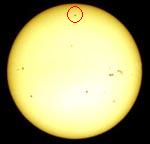
Animation of Mercury's transit.
Illustration: M. Federspiel / courtesy Prof.Dr. Udo Backhaus
(Project 6: The Transit of Mercury on May 7th, 2003)



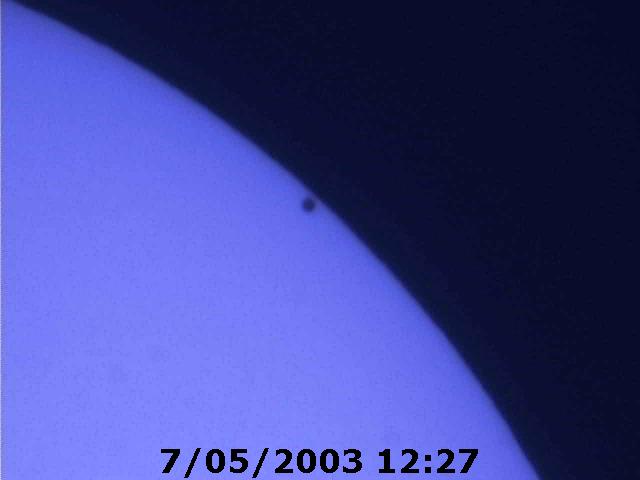
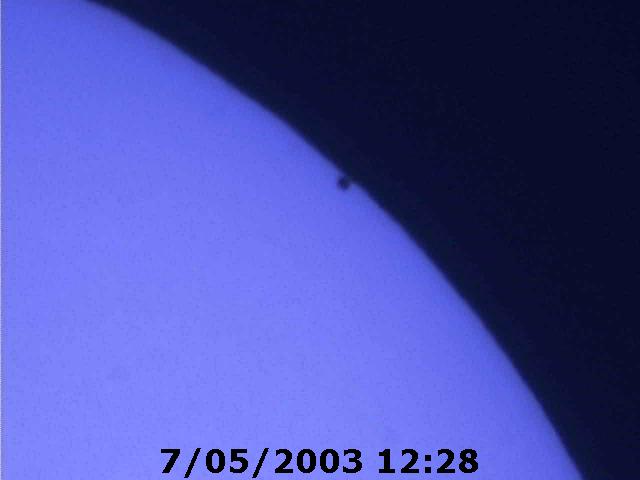
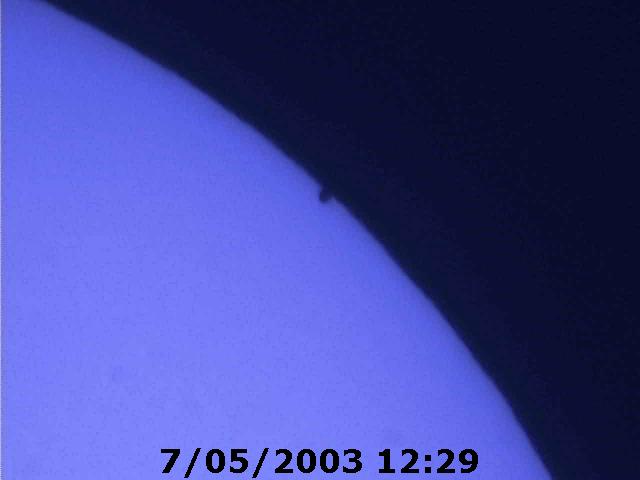
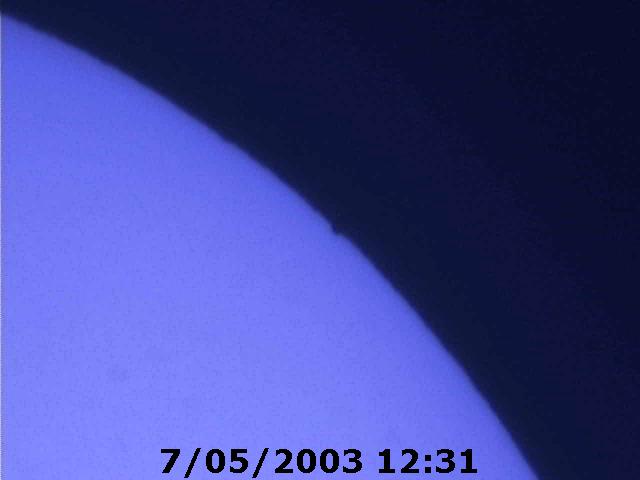


 10:27:26 UT
10:27:26 UT 10:30:11 UT
10:30:11 UT 10:30:24 UT
10:30:24 UT 10:33:04 UT
10:33:04 UT



